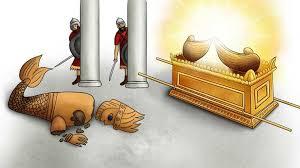The Ark at Ashdod
First Samuel 5: 1-7
The Ark at Ashdod DIG: How do the Philistines take different forms at different times? How does secular philosophy and science battle against ADONAI and His Word? Why did the Philistines place the Ark in Dagon’s temple? Why did Dagon keep falling over? Why did he lose his head and his hands? Why did they send the Ark to Gath?
REFLECT: Who are the Philistines today? What can God do against the Philistines? What are some examples? What can you do against the Philistines? The hand of the LORD was against the Philistines of old. How is His hand against them today? How did the incident of Dagon prostrating before the Ark foreshadow the future (see Philippians 2)?
When the Philistines captured the Ark and arrogantly treated ADONAI as though He were just another god, they invited the judgment of God upon themselves.
Philistines today: The apostle Paul informs believers that the events of the TaNaKh happened to them as an example and were written down for our instruction (First Corinthians 10:11). This shows that the principles taught by this ancient episode are relevant for us today. Like Isra’el of old, the Church in the West is in a state of weakness, having apparently been routed in the battle for our generation. Anyone who doubts this reality need only look at the news today: our land is dominated by Philistine powers with scarcely a hint of genuine godly influence. There are a string of parallels between the situation in First Samuel Chapters 4 and 5, and the Church of today. It is God, and God’s case, apparently completely routed and almost, it seems, destroyed by the god of this world (Second Corinthians 4:4a). The picture is that the enemy is triumphant and rejoicing.
The Philistine enemy takes different forms at different times. At the forefront of the unbelieving army today are secular philosophy and science. The world has always regarded those who believe in Yeshua Messiah as foolishness (see the commentary on First Corinthians, to see link click An – The Foolishness of Worldly Wisdom). Today, however, believers are pictured as spouting “hate speech,” and dangerous to the public good.
If anything, the assault from science is even more intense. It is not taken for granted in secular media and public education that Charles Darwin’s theory of evolution, published 166 years ago at this writing, not only shook, but destroyed the biblical account of the world, thus freeing “enlightened minds” from the shackles of biblical truth. As a result, on the surface, we might very well come to the conclusion that the modern-day Philistines have been as successful as their ancient prototypes. Many believe that they have demolished the Church altogether. The secularization of our lives seems to be almost complete.
Secular society has advanced from godless rationalism to godless hedonism. Even the building blocks of human society – gender distinctions and the institution of marriage – are under ferocious assault. So thorough is the postmodern Philistine victory that a large portion of the Church has virtually given up even trying to influence the culture around it, and frankly admits to adopting worldly Philistine values such as pragmatism, relativism, and debauchery as being a normal part of everyday life. Our situation is similar to that of Isra’el under the heel of the Philistines. The twentieth and twentieth-first centuries have been for us a massive defeat not unlike the Israelite calamity at Ebenezer (see Bb – The Philistines Capture the Ark).135
Yet it is not that the Philistines wanted to do away with God altogether. Their actions described here perfectly depict the attitude toward God today: When the Philistines had captured the Ark of God they brought it from Ebenezer to Ashdod, one of the five chief Philistine city-states (Joshua 13:3), three miles inland from the coast, and approximately thirty-three miles west of Jerusalem. Then the Philistines took the Ark of God and brought it to the temple of Dagon, their national god, where Sampson lost his life (Judges 16:23-30), and set it next to the idol (5:1-2). Ancient literature identifies this deity as a fish god, whose image had the lower body of a fish and the upper body of a man. Dagon seems to have been the leader of the Philistine pantheon and is noted to be the father of Ba’al. Placing the Ark in the temple of Dagon was supposed to be a sign of Dagon’s power and God’s inferiority – a visual representation that the god of the Philistines was victorious over the God of the Hebrews.136 So, they did not destroy the Ark, but instead they put it in their own temple near their god.
Similarly, the Philistine world today doesn’t really want to eliminate God, but only to domesticate Him. We see this truth in the desire of unbelievers to be married in a church. Even more, we see it in the use of a Bible and the invocation of God’s name when public officials are sworn into office. When Harry Truman was sworn in as president, he kissed the bible. You don’t see that anymore! Not many actually believe in the Bible and its teaching is forbidden in public affairs, but if it can be taken off the shelf to lend a little “holiness” to our government, then that is fine. Our courts and legislative sessions open with prayers for God to bless America, so long as God does not try to tell anyone what to do. This is what the Philistines intended for the Ark: God could remain if He knew His place and stayed quiet.
God and the Philistines: Most of the observations about the Bible in the world today could be made at the end of First Samuel 4, when the surviving widow of ‘Eli’s house died with the word Ichabod, “the glory has departed,” on her lips. So, what does Chapter 5 have to say? We might put it this way: whereas Chapter 4 shows the weakness of a spiritually corrupt and fallen Church against the Philistine powers, Chapter 5 asks, “What can God do about the Philistines?” They are, after all, God’s enemies as well as His people’s, so what will God do to the Philistines? The answer is provided in dramatic fashion. Early the next morning, when the people of Ashdod got up, there was Dagon, struck down, flat on his face before the Ark of God. Undeterred, they took Dagon and set him in his place again (5:3).137 The fact that they had to stand him up again should have told them that their god couldn’t even take care of himself, let alone any of them! But they didn’t learn anything, so shortly they would have to learn the lesson a second time.
The Philistines, however, failed to deal with the power of YHVH. The battle was not between Isra’el and the Philistines; but between Isra’el’s God and the gods of the Philistines. They had not adequately understood Ha’Shem’s first two commandments (Exodus 20:3-6). They did not understand that a god like Dagon, who was made out of wood, had no real power and was no match for ADONAI. As a result, even the capture of the Ark, the precious symbol that it was, could not stop the LORD’s actual power.

But on the second day, the drama intensified. Dagon had been propped up again, as all idols must be (see the commentary on Isaiah Ig – Bel Bows Down, Nebo Stoops Low and They Go Off Together to Captivity). Nevertheless, they found Dagon face down before the Ark. Early the following morning, when they got up, Dagon had again fallen down with his face to the ground before the Ark of ADONAI. The fake god, who had been propped up, had been knocked down by the real God. But this time, the head of Dagon and both hands lay there, severed, on the threshold; all that was left of Dagon was his disfigured torso. Then they should have known that the God of Isra’el was the only powerful God, they had no excuse (see Romans Al – The Evidence Against the Pagan Gentile). This is why, to this day, the priests of Dagon and those entering his temple never walk on the threshold of Dagon in Ashdod (5:4-5). Over time a superstition developed among the Philistines that the threshold of the temple was cursed because the head and hands of Dagon had fallen on it. For that reason, they would leap over it (Zephaniah 1:9). The presumed power of Dagon, which seemed so real after the routing of the Israelites at Ebenezer, was exposed for what it was, so much wind and waste (Isaiah 41:29). Yet YHVH, who was presumed defeated, acted so powerfully as to dominate even their foreign temples. Ironically, God had, in fact, captured that alien temple of Dagon so that it then, in effect, belonged to Him.138
In the ancient world, severed heads (see the commentary on the Life of David Al – David Kills Goliath) and severed hands (Judges 8:6) were battlefield trophies that assisted the victor in establishing the correct body count. ADONAI had defeated Dagon in his own temple, a premonition of things to come. At the temple of Dagon in Gaza, the power of God – symbolized by the hair on Samson’s head and the strength of his hands – had defeated the Philistines and their god (see the commentary on Judges By – The Death of Samson).
The hand of the LORD: With the reference to Dagon’s hands being rendered helpless, the Ruach Ha’Kodesh introduces a major motif of the hand of the LORD. This motif is so common within the Ark narratives (4:1b-7:1) that it is found eight times (4:8, 5:6, 7, 9, 11, and 6:3, 5, 9). The first reference came from the lips of the Philistines, who related the divine hand to the plagues of Egypt (4:8), and rightly so (Exodus 9:3). They did not take lightly the possibility that the fate of the Egyptians might happen to them also (6:6).139
As if the downfall and fragility of Dagon had not yet been enough to demonstrate his impotence, and the superiority of ADONAI, the next event emphasized the point even more. The people of Ashdod recognized the terrifying plague that struck their city as the hand of the LORD.140 He ravaged them, striking Ashdod and its surrounding area with tumors. When you put all the evidence together, it seems that YHVH sent infected mice (6:4) among the Philistines and spread a terrible plague (also see Isaiah Gw – Then the Angel of the LORD Put to Death a Hundred and Eighty-Five Thousand Men in the Assyrian Camp). According to the covenant, God should have sent that affliction on the disobedient Jews (Deuteronomy 28:58-60). But in His grace, He punished the enemy. When the Philistines captured the Ark and arrogantly treated ADONAI as though He were just another god, they invited the judgment of God upon themselves.141 When the people of Ashdod came to understand what was happening, they couldn’t get rid of the Ark fast enough. They cried out: The Ark of the God of Isra’el can’t remain with us, because He is oppressing us and our god Dagon (5:6-7). By removing the Ark elsewhere, the Philistines believed that Ashdod would find healing. Consequently, they immediately sent the Ark to Gath (see Bg – The Ark at Gath), hoping a change of scenery would change the results.
Dear Heavenly Father, Praise You for Your Awesome love and almighty power! Yes, You are a God of great love, and You are also the mighty Sovereign Ruler of the universe and more powerful than all the armies of the entire world (Revelation 19). You are a God to be both greatly loved and feared in a holy and reverent way. Your Word is so powerful that You win the battle by Your Word! Then I saw heaven opened, and behold, a white horse! The One riding on it is called Faithful and True, and He judges and makes war. His eyes are like a flame of fire, and many royal crowns are on His head. He has a name written that no one knows except Himself. He is clothed in a robe dipped in blood, and the name by which He is called is “the Word of God” (Revelation 19:11-13). We worship You our loving, powerful and Almighty Heavenly Father! In Messiah Yeshua’s Name and power of His resurrection. Amen



Leave A Comment